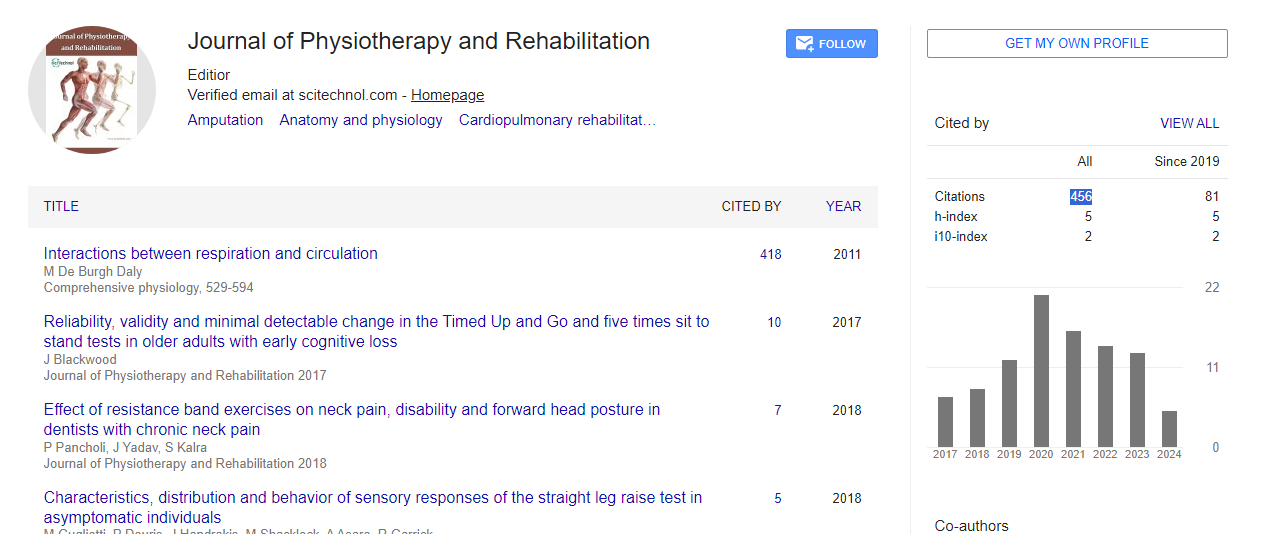Perspective, J Physiother Rehabil Vol: 5 Issue: 12
A Prospective, Population-Based Cohort Study
Golditch Ira*
Department of Obstetrics and Gynecology, Kaiser San Francisco University, San Francisco, CA
*Corresponding author: Golditch Ira, Department of Obstetrics and Gynecology, Kaiser San Francisco University, San Francisco, CA, E-mail: golditch.Ira@utes.edu.in
Received date: 01 December, 2021; Accepted date: 16 December, 2021; Published date: 23 December, 2021
Citation: Ira G (2021) A Prospective, Population-Based Cohort Study. J Physiother Rehabi 5:12.
Abstract
Prospective longitudinal studies of obsessive-compulsive disorder (OCD) and sub-diagnostic obsessive-compulsive symptomatology in the non-clinical population, using age-defined cohorts, are rare. This study aimed to investigate the effect of OC symptoms on distress and psychosocial function and the effect of early-onset OC symptoms. 591 subjects drawn from the general population of Zurich, Switzerland were interviewed seven times between 1979 (at age 20/21) and 2008 (age 49/50). Data for socio-demographic variables and psychosocial impairment was also collected and compared with a control-group without OC symptoms drawn from the same population. The unweighted cumulative one-year rate of OCD in this sample was 5.1% and 21.7% reported some degree of clinically-relevant OC symptomatology (OCD or OCS). OCD appeared more prevalent in females whereas OCS and OC symptoms were more prevalent in males. The weighted cumulative prevalence rates, representative of the general population, for OCD, OCS and OC symptoms were 3.5%, 9.7%, and 11.2%, respectively. We could not identify OCD occurring before the age of 10 years, though sub-threshold cases were reported as early as age 2 years, whereas by the age of 22 years, around two thirds of OCD cases had emerged and no new cases developed OCD after around 37 years. Males were statistically significantly younger than females at onset of any OC symptomatology. Clinically-relevant OC syndromes start early and are associated with substantial distress, treatment-seeking activity and in the case of OCD, functional disability.
Keywords: Population-Based Cohort, socio-demographic, Clinically-relevant
Description
Prospective longitudinal studies of obsessive-compulsive disorder (OCD) and sub-diagnostic obsessive-compulsive symptomatology in the non-clinical population, using age-defined cohorts, are rare. This study aimed to investigate the effect of OC symptoms on distress and psychosocial function and the effect of early-onset OC symptoms. 591 subjects drawn from the general population of Zurich, Switzerland were interviewed seven times between 1979 (at age 20/21) and 2008 (age 49/50). Data for socio-demographic variables and psychosocial impairment was also collected and compared with a control-group without OC symptoms drawn from the same population. The unweighted cumulative one-year rate of OCD in this sample was 5.1% and 21.7% reported some degree of clinically-relevant OC symptomatology (OCD or OCS). OCD appeared more prevalent in females whereas OCS and OC symptoms were more prevalent in males. The weighted cumulative prevalence rates, representative of the general population, for OCD, OCS and OC symptoms were 3.5%, 9.7%, and 11.2%, respectively. We could not identify OCD occurring before the age of 10 years, though sub-threshold cases were reported as early as age 2 years, whereas by the age of 22 years, around two thirds of OCD cases had emerged and no new cases developed OCD after around 37 years. Males were statistically significantly younger than females at onset of any OC symptomatology. Clinically-relevant OC syndromes start early and are associated with substantial distress, treatment-seeking activity and in the case of OCD, functional disability.
Cohort Study
To study the effect of magnetic fields on the risk of miscarriage, we conducted a population-based prospective cohort study among pregnant women within a large health maintenance organization. All women with a positive pregnancy test at less than 10 weeks of gestation and residing in the San Francisco area were contacted for participation in the study.
We conducted in-person interviews to obtain information on risk factors for miscarriage and other potential confounders. All participants were also asked to wear a magnetic field-measuring meter for 24 hours and to keep a diary of their activities. Pregnancy outcomes were obtained for all participants by searching the health maintenance organization’s databases, reviewing medical charts, and telephone follow-up. We conducted a population-based prospective cohort study among eligible female members of the Kaiser Permanente Medical Care Program (KPMCP) in Northern California. All KPMCP women who resided in San Francisco County and adjacent parts of San Mateo County and who had a positive pregnancy test at either the San Francisco or the South San Francisco KPMCP facility from October 1996 through October 1998 were identified through the computerized laboratory database as potential eligible subjects. A woman’s second pregnancy, if any, during the study period was not eligible for the study. An invitational flyer describing the purposes and procedures of the study was distributed to every woman who submitted a urine sample for a pregnancy test. The flyer included a postage-paid and self-addressed return refusal postcard. Those women with positive tests from whom we did not receive the refusal postcard were contacted by a well-trained female interviewer to determine their eligibility for the study. All English-speaking women who indicated their intention to carry their pregnancy to term at this contact and whose gestational age at the pregnancy test was 10 complete weeks or less were eligible for the study.
 Spanish
Spanish  Chinese
Chinese  Russian
Russian  German
German  French
French  Japanese
Japanese  Portuguese
Portuguese  Hindi
Hindi 